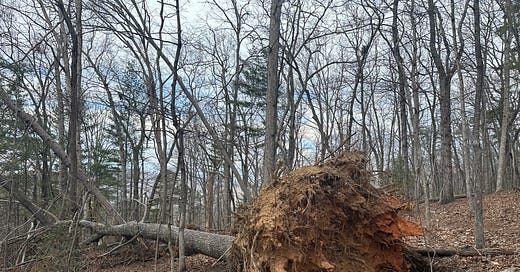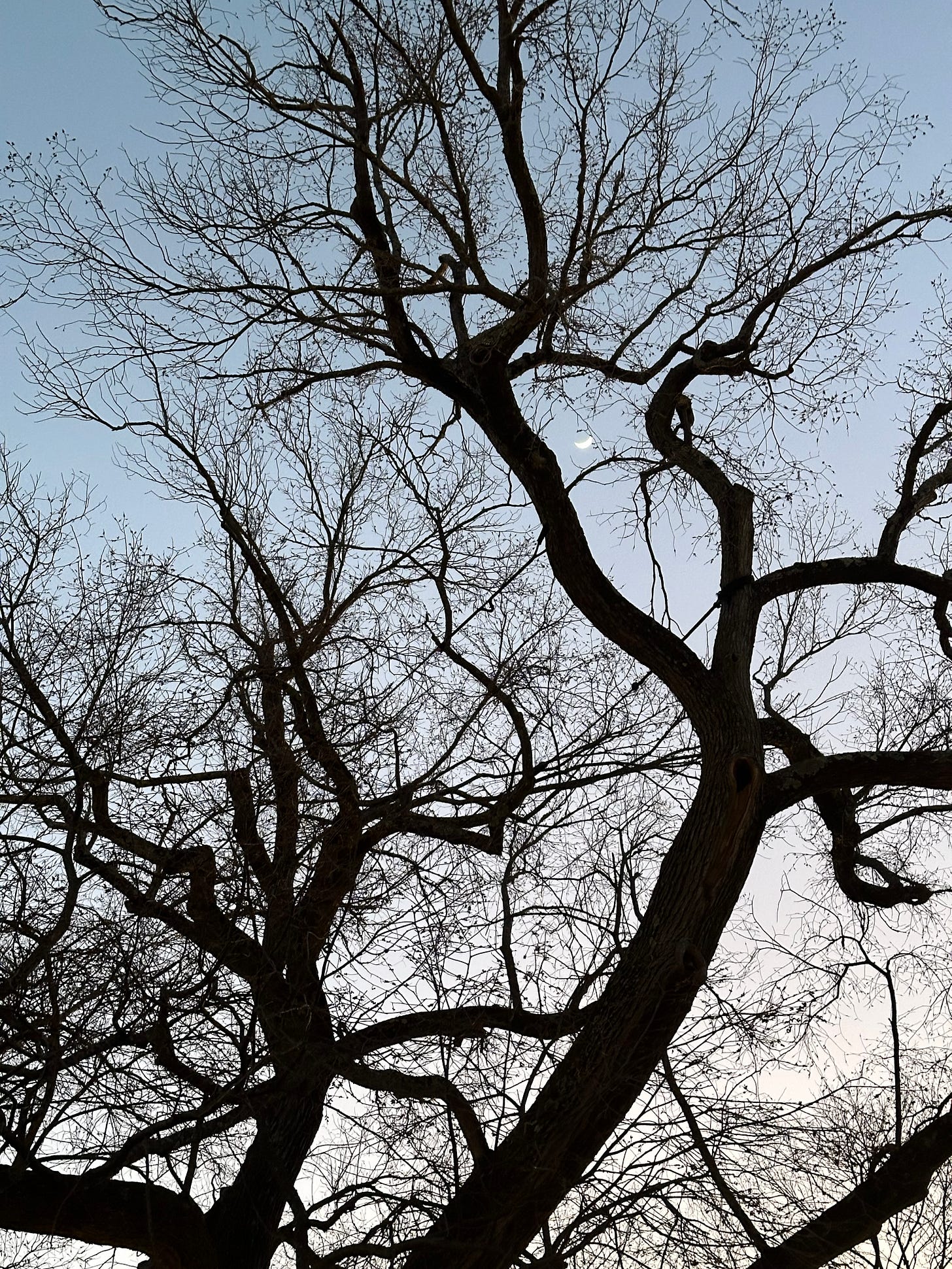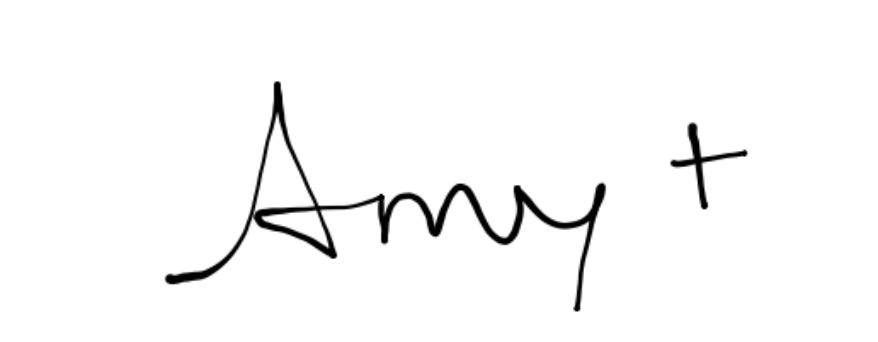I want to tell you about a walk I took in the woods this week. It was Thursday. I had just written the note to go at the top of our weekly church newsletter – just a quick note about the way that last year, as I left church after our Shrove Tuesday pancake supper, I was arrested by the view of the sunset and the silver sliver of moon in the courtyard. It occurred to me, in that moment, that if it were summer, I wouldn’t have been able to see the moon, or all the sunset colors. The elm tree in the courtyard would have been too full, and blocked my view.
But because the tree had let go of its leaves over the winter, I could see the sky. In those empty spaces between the bare branches, beauty. “That’s the image I hold onto as I consider what I hope for in Lent, which begins this Wednesday,” I wrote. “What can I let go of for a time so that I may see God’s beauty and love more clearly? What is feeding my rage? – or my complacency? – what’s helping me numb out to reality? – what’s keeping me from looking at my life from God’s perspective? These are the things I may try to let go of, in this season, so that I may see the love of God more clearly.”
I sent the note to Ken to add to the newsletter, and went upstairs to reheat my Shanghai leftovers for lunch. As they warmed in the oven, I re-read the Scriptures appointed for this Sunday. Clouds, veils, mountaintops, kings. Jesus was praying on a mountain when he was changed by a vision. So I ate my lunch and brushed my teeth and left my headphones on my desk and started the climb up my own bit of mountain, the trail through the forest between my house in east asheville and the blue ridge parkway, and I prayed.
It was a beautiful day— sunny, with dark blue storm clouds in the distance, just a faint chill in the air. And I did see something more clearly. The longer I walked, the more I realized that there’s not even a ten foot stretch of trail that doesn’t display the damage done by Helene.
Most of the path is traversable, though immediately after the storm it was totally inaccessible; but what was cleared by chainsaws now lays piled on either side of the path; and after a while, as I walked, each felled tree hit me harder and harder. Photos can’t convey the damage adequately. There are root balls twice my height. At one spot, I stopped and counted how many enormous trees within my view were completely fallen. Just looking to my left, there were eight.
I’ve walked this path a couple of times in the months since Helene, but those walks were back in November before all the leaves had fallen, or more recently, but only in the light of dusk, and deep in conversation. My life has been busy and full; we’ve all been recovering and moving on. It sometimes seems that we hardly speak about Helene anymore; and I’ve learned to drive quickly and blindly past the particular roadsides where the destruction still screams.
Something was clearer on this day, as I walked at my human pace, and listened only to the woodpeckers knocking and the squirrels rustling through the dead leaves, and watched the bluebirds and cardinals swoop by. All the living trees are still bare from winter’s loss, and whether I looked up or down or left or right – in the space opened up by the leaf fall and illuminated by the bright midday light– the damage was clear. Stark and unavoidable.
Then I had a premonition, and opened my calendar and looked at the dates. It was February 27, five months to the day.
*
Clearing space in Lent – letting go of those things that we use to distract ourselves so that we may see more clearly – will not only make space for us to see the beauty of God’s love and care, the crescent moon in the sunset sky – it may also make space for us to see painful things we have been avoiding.
*
My praying on the mountain did not transfigure me, as far as I could tell; it just left me feeling a little hollowed out, and sad.
But I’ve had some mountaintop moments in my life – haven’t you? – rare though they are, there are moments I can recall when a prayer I never expected to be answered was answered. When my insecurities were just suffused by a love so great that they disappeared. When my loneliness was replaced by a sense of God’s presence, if just for an hour. When a decision I struggled to make became clear as day. When I felt the presence of God so plainly and yet inexplicably that I felt I’d do anything to just stay there, on the mountaintop.
This is one reason we read this transfiguration story every year right before Lent begins. Because what is next will include some wilderness and temptation,
some stark revelation of the damage around us, some setting our face towards a future that will include betrayal and suffering and sacrifice before we see resurrection.
That’s what is next in our church calendar. It may also be what is next for us in our everyday lives, and for longer than the six weeks of Lent. And so we need a reminder to hold on to whatever small moments of clarity and glory we’ve had if we are going to be able to persevere.
Those moments are often small, and they’re hidden, and they’re personal. Only a few people saw Jesus transfigured and talking with his ancestors. Nothing dramatic in the world immediately changed because of it. But those disciples were changed. They began to be transformed from glory into glory. They were given work to do, and as they did it, they did not lose heart.
As my forest path turned and I set my face toward home, a praise song from the nineties came into my head: show me your glory, send down your presence, I want to see your face. I thought more about the dead trees along my path. I prayed that this damage wouldn’t lead to more – that it wouldn’t become dry brush ready for a fire, but that it would feed the forest floor. That those fallen trees would be homes for wildlife, that they would serve as food for flora and fauna, and foster endangered species. I listened to the woodpecker beating its own rhythm into the tree above my head, and I thought about something I read last year – that it takes about two weeks for a woodpecker to make a home in a tree. It’s faster if the tree has a fungal disease that has softened it. I thought about the fact that woodpeckers move every year, and so every year they leave behind the wounded trees, with holes, homes, ready for carolina chickadees and nuthatches and birds that are smaller and weaker to move in.
Maybe seeing the damage becomes its own kind of seeing the glory.
Maybe Jesus transfigures it, and us.
Maybe the spaces hollowed out in us can help us be homes for each other.
Three(ish) Things:
One thing we can do, anyway, is keep telling the truth.
Speaking of Margaret Renkl, Trinity is one of the hosts bringing her, Jeff Chu, and Kathleen Biggins to our spring series Restoring and Protecting Asheville: Science and Storytelling Show Us How. If you’re nearby, register! The events are all free.
Eventually, I think I’ll have a playlist for every Sunday in the three year lectionary cycle — weird, idiosyncratic playlists made up of CCM and indie folk that maybe no one else would associate with the texts as well as choral hymns suggested for the day. Here are some transfiguration songs.
My favorite breakfast.
I’m not preaching this Sunday, but if I were, I’d preach on the Psalm (91), and I’d be meditating on these works of art and dipping into this history of the Psalm.
Ash Wednesday, by Anya Silver:
How comforting, the smudge on each forehead: I’m not to be singled out after all From dust you came. To dust you will return. My mastectomy, a memento mori, prosthesis smooth as a polished skull. I like the solidarity of this prayer, the ointment thumbed into my forehead, my knees pressing hard on the velvet rail. If God won’t give me His body to clutch, I’ll grind this soot into my skin instead. If I can’t hold the flame that burned my breast, I’ll char my brow; I’ll blacken my pores; I’ll flaunt with ash this flaw in His creation.
Dangerous Territory is now available in an updated second edition and as an audiobook! Buy it in paperback or ebook at Bookshop, Amazon, or Barnes and Noble.
Where Goodness Still Grows is available wherever books are sold.







I remember you looking at (and through) that bared tree. I suspect that tree remembers, too. I especially loved the bit on woodpeckers and the Ash Wednesday poem you brought us. And the NYTimes piece. And your playlists. And your good thinking and deep feelings. Thanks for helping me buckle up for Lent.